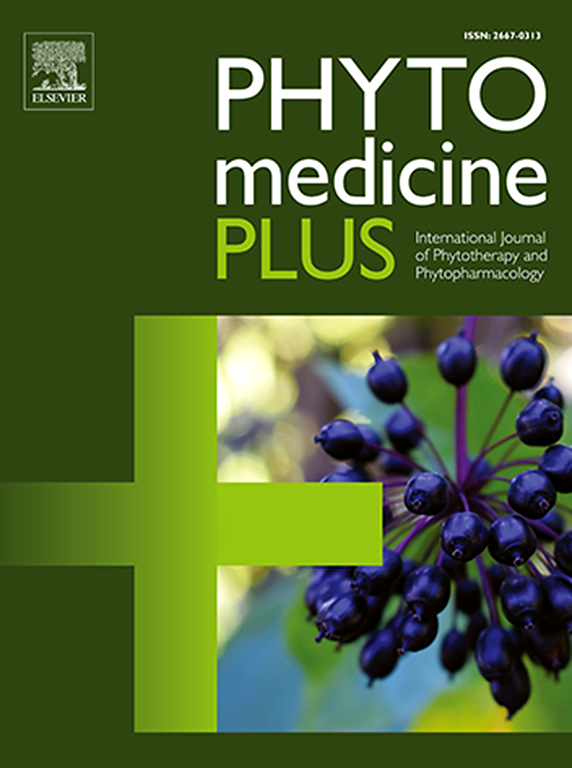通过对艾叶的共性、真实性和老化等方面的研究,探索艾叶的活性成分和药理作用
Q3 Pharmacology, Toxicology and Pharmaceutics
引用次数: 0
摘要
艾叶蒿(a.a argyi)是一种广泛应用于艾灸治疗的关键草药,因其显著的临床疗效而被广泛认可。由于药物的治疗效果与其化学成分有着内在的联系,因此鉴定艾叶中潜在的活性化合物成为不断推进艾灸的重点之一。因此,本研究旨在通过文献数据挖掘,提取对其具有药用价值的关键生物活性化合物。采用共性、真实性和陈化三个标准对不同地区的常见化合物进行鉴定;正宗祁春艾叶特有的优质化合物;以及在老化过程中产生的独特化合物。方法数据驱动的方法是通过几十年的文献挖掘而发展起来的,它基于传统的评估原则,如共性、真实性和老化性。用3个个体类风湿关节炎(RA)相关的原代成纤维细胞样滑膜细胞(FLS)与3次实验验证了生物活性化合物的治疗效果。利用CCK-8实验和实时细胞分析(RTCA)系统评估抗增殖作用。此外,还通过RTCA评估其抗创作用,并通过酶联免疫吸附试验(ELISA)研究其抗炎作用。结果重点鉴定了银叶香叶中潜在的关键功能化合物,包括挥发性物质1,8-桉树脑、β-石竹烯、对石竹烯和氧化石竹烯,以及非挥发性物质绿皮苷、异绿原酸C、异绿原酸A和牡荆素。我们进一步在体外验证了这些化合物对RA- fls的抗增殖、抗侵袭和抗炎作用,证明了它们在RA中的治疗潜力。结论基于共性、真实性和衰老性三个标准,鉴定出艾叶中可能通过改变细胞病理表型发挥治疗作用的活性物质。本研究为艾叶的药理研究提供了新的思路,并阐明了未知的抗类风湿性关节炎的治疗机制。本文章由计算机程序翻译,如有差异,请以英文原文为准。
Exploring the active chemical compounds and pharmacological effects of Artemisia Argyi leaves through commonality, authenticity and aging
Background
Artemisia argyi (A. argyi), a pivotal herb extensively used in moxibustion therapy, has long been widely recognized in Traditional Chinese Medicine (TCM) for its significant clinical efficacy. Since the therapeutic effects of a drug are inherently linked to its chemical composition, the identification of potential active compounds in A. argyi leaves becomes one of the priorities for continuously advancing moxibustion.
Purpose
Hence, this study aims to extract key bioactive compounds contributing to its medicinal properties by performing data mining from literature. Three criteria, commonality, authenticity and aging, are applied to identify the common compounds across different regions; the superior compounds unique to the authentic Qichun A. argyi leaves; and the distinctive compounds emerging during the aging process.
Methods
Data-driven approaches, which have been developed through decades of literature mining, are grounded in conventional evaluation principles of commonality, authenticity, and aging. The therapeutic effects of bioactive compounds have been verified using 3 individual rheumatoid arthritis (RA)-associated primary fibroblast-like synovial cells (FLS) with 3 times. The anti-proliferative effects were assessed utilizing the CCK-8 assay and the real-time cell analysis (RTCA) system. In addition, the anti-invasive effects were also evaluated through RTCA, while the anti-inflammatory effects were investigated using enzyme-linked immunosorbent assays (ELISA).
Results
Our work highlights the potential key functional compounds of A. argyi leaves, including volatile substances, including 1,8-Cineole, β-Caryophyllene, p-Cymene and Caryophyllene oxide, as well as non-volatile compounds, including Eupatilin, Isochlorogenic acid C, Isochlorogenic acid A, and Vitexin. We further validated the anti-proliferative, anti-invasive and anti-inflammatory effects of these compounds on RA-FLS in vitro, demonstrating their therapeutic potential in RA.
Conclusion
This approach, established by three criteria, commonality, authenticity and aging, has identify bioactive compounds in A. argyi that may play a therapeutic role by altering the pathologic phenotype of cells. This study provides insights towards pharmacological research of A. argyi and elucidates unknown therapeutic mechanisms against RA.
求助全文
通过发布文献求助,成功后即可免费获取论文全文。
去求助
来源期刊

Phytomedicine Plus
Medicine-Complementary and Alternative Medicine
CiteScore
3.70
自引率
0.00%
发文量
178
审稿时长
81 days
期刊介绍:
 求助内容:
求助内容: 应助结果提醒方式:
应助结果提醒方式:


